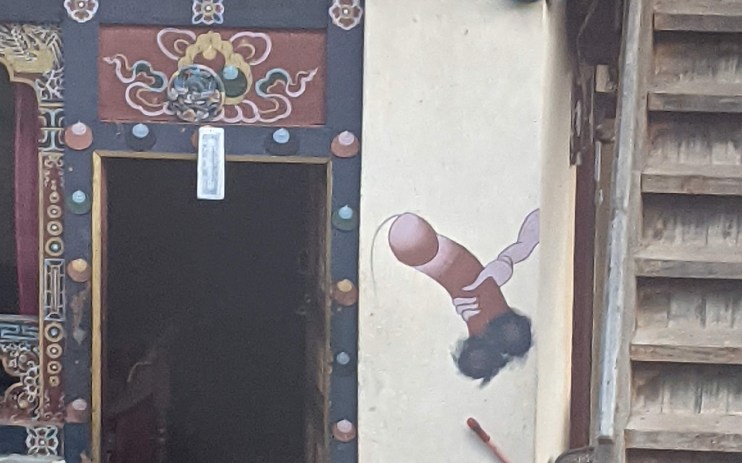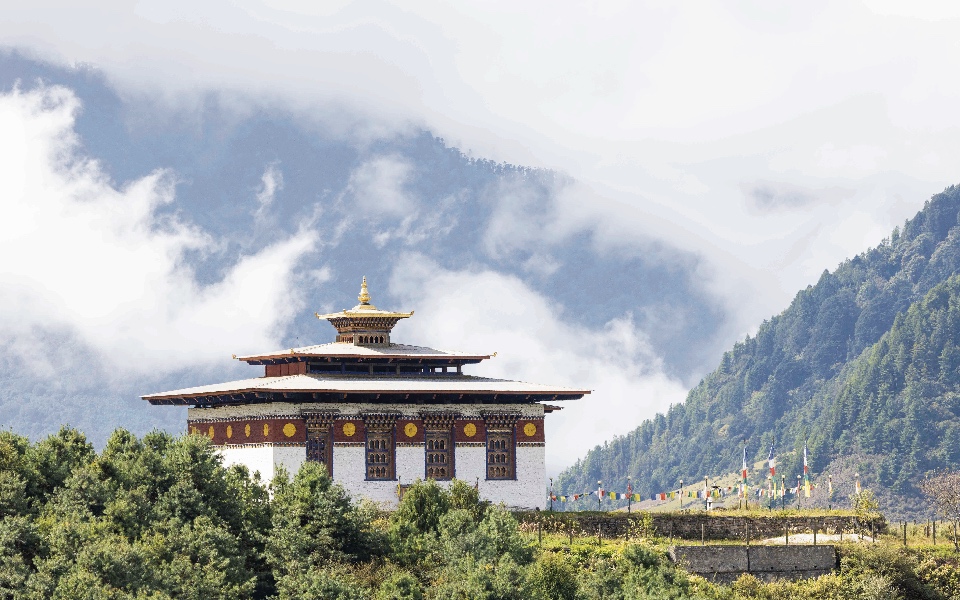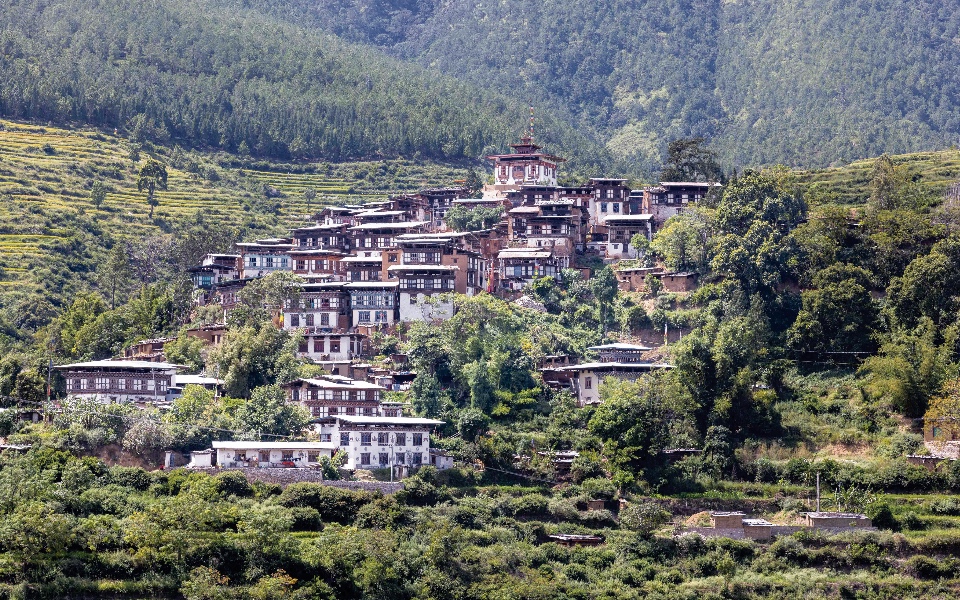The Divine Madman of Bhutan and his legacy of many penises

I knew two things about Bhutan before landing: there are no traffic lights in the entire country, and happiness comes before anything else. I had no idea that some of the buildings have penises.
Bhutan is a mysterious, historically-hermitted nation high in the Himalayas, which, thanks to geographic and governmental hurdles remains one of the least discovered countries in the world.
Travel restrictions have finally relaxed after the pandemic, but the floodgates are far from open – a small number of high quality tourists would make the Bhutanese much happier than the backpacking hippy parade that is currently trying to find itself in neighbouring Tibet and India.
In search of these “high quality” – read “wealthy” – tourists, the country was earlier this year charging a
$200 daily tourist fee – possibly the highest tourist tax anywhere in the world. It has since been lowered to $100 in view of “boosting overall economic growth.”
I came to Bhutan for the launch of a new hiking trail, which stretches from the urbanised West, across mountains, to the sparsely populated East. Bhutan is a naturalist’s joy, with an abundance of wildlife, flora and undisturbed national parks. The Trans Bhutan Trail follows an ancient route that has been out of action since the 1960s when the introduction of the road transformed a 30-day trek into a day-or-two in the car.

The trail arches through misty mountain passes and reaches deep into the rice paddy valleys via steep rock paths scattered with pine needles. Bhutan is different; even the cows look weird. They point their triangular bottoms in the air to stabilise themselves whilst munching on the undergrowth. It’s as if nature has answered the burning question of what the cow emoji would look like IRL.
Along the route, temples dating back as far as the 17th century form the backbone of a surprisingly phallic pilgrimage, as if a country with 72 per cent forest cover were in any need of additional wood.
It’s the second day of my visit when I spot the first phallus painted, in quite some detail, on the front wall of a house. Out of politeness I don’t draw attention to it – we have similarly themed graffiti in London, though our cock-and-ball taggers haven’t put in nearly as much effort to capture the full veiny essence of their
subject matter.
We have similarly themed graffiti in London, though our cock-and-ball taggers haven’t put in nearly as much effort to capture the full veiny essence of their
subject matter.
It’s only once I’ve seen three hairy, seven-foot erections on perfectly respectable residences that I decide this must be something to talk about. All tourists are accompanied by a government-approved guide and mine – Lhakpa – is going to take me to a temple where he promises it will all make sense: the Fertility Temple of the Divine Madman.
Couples visit the Fertility Temple in Punakha from all over the world, especially those who have experienced challenges conceiving, to seek the assistance of a monk who officiates a fertility ritual which involves the lady strapping a three-foot wooden sculpture of a penis to her back and parading around the external perimeter of the temple in a clockwise direction. After making an offering at the altar, the couple then selects a name (pick-a-card-any-card style) from the shrine to use when their child is born.
The Divine Madman
After prostrating himself and making an offering at the shrine, Lhakpa ushers me into a corner of the decadently decorated room and explains its significance in a hushed seriousness. The Divine Madman was a Buddhist teacher from Tibet who developed some rather unorthodox teaching practices, which led to him having to leave the sanctum of the monastery.

You see, the Divine Madman found that he was best able to convey messages, not by chanting or solitary meditation, but by way of his penis, and given his speculated 500 offspring, he apparently found no shortage of students.
There is some evidence that the Divine Madman was real. He was a 15th Century Tibetan monk called Drukpa Kunley, exiled from Tibet for his unorthodox practices…. of having sex… But I’m pretty sure the flame-throwing phallus part is more legend than truth.
You see, according to the stories, the Divine Madman’s whistle doubled as a flame-thrower, which was extraordinarily well-suited for the challenging task of subduing demons and it is for protection that locals adorn their front walls with ejaculating demon-defeaters.
I’m listening for a “so the legend goes” or “traditionally people believe” but it doesn’t come. Lhakpa seems entirely sincere in recounting the chronicles of the Divine Madman, though perhaps this reflects his skill as an official guide, a role which requires intensive training and examination in Bhutan.
Spirituality is central to Bhutan’s culture. Prayer flags are everywhere, natural streams spin prayer wheels, scattering the air with blessings, and monks are financially buoyed by the government in return for their spiritual dedication.
The Divine Madman’s junk doubled as a flame-thrower, which was extraordinarily well-suited for the challenging task of subduing demons
Monks’ special status is impressed upon revellers outside Thimpu nightclubs where signs prohibit “monks, children and weapons” – quite the trio – and Lhakpa respectfully adjusts his knee-length socks anytime we pass someone wearing crimson robes on the street. But they’re also a part of regular life – young monks play football during breaks from classes, and older monks scroll on their smartphones at the side of the street.
My journey along the Trans Bhutan Trail takes me as far as Bumthang, a valley town on the border of central and eastern Bhutan, where locals dry chilli on their metal roofs ahead of winter and the school football team trains late into the night under a harshly floodlit pitch. If you want to eat like a local, let your guide know as they won’t assume it. I’ve been warned that Bhutanese like their food hot and I’m willing to give it a go.
The main street in Bumthang is on a slight hill leading to a bridge crossing the river. At the top of the hill, close to the junction, there’s a small restaurant with four tables and a side counter selling shampoo and sun cream. There are no menus – you either want to eat or you don’t. Lunch is a ramen-like soup, sprinkled with dried beef, bulked out with wide flat noodles and flavoured with lime. I’m relieved that it’s not spicy; chilli flakes on the table allow patrons to self-spice. Lhakpa turns his golden broth red with flakes, I just tuck in. About 98 percent of Bhutan’s tap water is now safe to drink – a major development of recent years – however, in-keeping with the technicolour shrines, it’s yellow, so I wash down lunch with a mug of tea instead.
For a small town, there are three karaoke bars and we return in the evening for a laugh with the locals, who apparently go here to hide from their parents. Before we start singing I go to Dragon Handicrafts – a smorgasbord of antiques, traditional art and local crafts – to buy a gift for my sister and her husband. They’re only just married, so I don’t mean to put them under any pressure, but should they want to start a family… Well, a little wooden phallus isn’t going to hurt their chances, is it?
NEED TO KNOW
A four-day trip starts from £1,210, based on two people sharing. The price includes accommodation, meals, guide, SDF fee and visa (excludes international flights). For more information, visit here